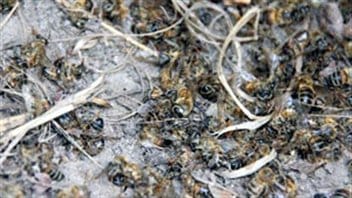In an effort to protect pollinating bees, Ontario farmers are being told to change some habits as they plant seeds this season.
The vast majority of corn and soybean seeds now come pre-coated with a type of insecticide known as neonicotinoids. During planting the coated seeds scrape against each other creating toxic dust which floats into surrounding areas. Sometimes a lubricant is used, such as talc, to keep the seeds flowing. This however also adds to the toxic dust, which has been linked to vast bee die-offs in recent years.

The federal Pest Management Regulatory Agency (PMRA) and in the province of Ontario, the Ontario Ministry of the Environment, have told farmers they can now only use a specific product, Bayer CropScience lubricant in their equipment in order to minimize the production of toxic dust.
However, Dennis Edell with the Ontario Beekeepers Association, says there are no plans to enforce these guidelines either federally or in Ontario.
Canadian beekeepers have been lobbying hard to have neocotinoids banned entirely while farmers groups say the insecticides are needed to protect crops from damaging insects. Other campaigns meanwhile, are saying that the science linking “neonics” to bee deaths is not clear, and more study is needed, not a ban.
It should be noted that wild bees do most of nature’s critical pollination, and while it is easy for domestic beekeepers to tally the numbers and percentages of their bee die-offs, the affect on the wild bee population is impossible to calculate. Scientists are greatly concerned about what affect the loss of wild bees may have on pollination in nature.
Meanwhile studies have shown connections between bee die-offs and insecticides. One such study by researchers at Purdue University in the US, has found high concentrations of neonicotinoid insecticides, commonly used as seed treatments in corn and soybean production, in the bodies of bees found dead around their hives.
The study was published in the online Journal PLoS One. It also found other insecticides, clothianidin and thiamethoxam were consistently detected at low levels in soil – up to two years after treated seed was planted – on nearby dandelion flowers and in corn pollen gathered by the bees,
Research indicated that corn pollen carried by bees later in the year tested positive for neonicotinoids, and if consumed in large enough quantities could kill the bees. Small doses of the “neonics” and other insecticides are believed to disrupt the bee’s brains and nervous system which could negatively affect homing capacity, feeding, and other behaviours which could also lead to death
Affect on birds.

In western Canada, a University of Saskatchewan biologist says many wetlands across the Prairies are being contaminated by this relatively new pesticide that she says is threatening the ecosystem.
Christy Morrissey says that over the past few years neonicotinoids have been used increasingly on crops in Western Canada and the chemical is making its way into wetlands, potentially having a devastating “domino effect” on insects, fish, amphibians, and the birds that rely on them.
Morrissey is just a year and a half into a four-year study, but she’s alarmed by what she’s finding.
“This is huge” Morrissey said. “The impact on biodiversity could be probably bigger than we’ve ever seen before if we keep going at this rate.”
Virtually all of the 8.5 million hectares of canola planted in Saskatchewan, Manitoba and Alberta are now treated with them.
(with additional files from CBC)
Ontario Beekeepers- five facts about neocotinoids
Grain Farmers of Ontario on neonics







For reasons beyond our control, and for an undetermined period of time, our comment section is now closed. However, our social networks remain open to your contributions.